Business Sustainability in Real Estate Industry: A Research Report
VerifiedAdded on 2019/10/31
|15
|3403
|43
Report
AI Summary
This research report examines business sustainability within the real estate industry, with a specific focus on the New Zealand market. The report explores the aim of the research, which is to determine the viability of investments in the real estate sector based on its sustainability. It outlines the objectives, including assessing financial, social, and political aspects; identifying factors impacting business continuity; and finding solutions for businesses facing sustainability challenges. The literature review covers various dimensions of sustainability, including the relationship between businesses and their stakeholders and the environment. It highlights the importance of social and environmental sustainability, and how these factors influence business success. The report then discusses factors affecting business sustainability, such as technology, infrastructure, institutional practices, and market understanding. It also examines potential solutions, including infrastructure development, adherence to strict regulations, and the adoption of innovative sales and marketing strategies. The research methodology involves qualitative research methods, including questionnaires and data mining. The report also outlines the research instruments, participants, ethical considerations, and a proposed time schedule. The research aims to provide valuable insights for investors and businesses in the real estate sector.
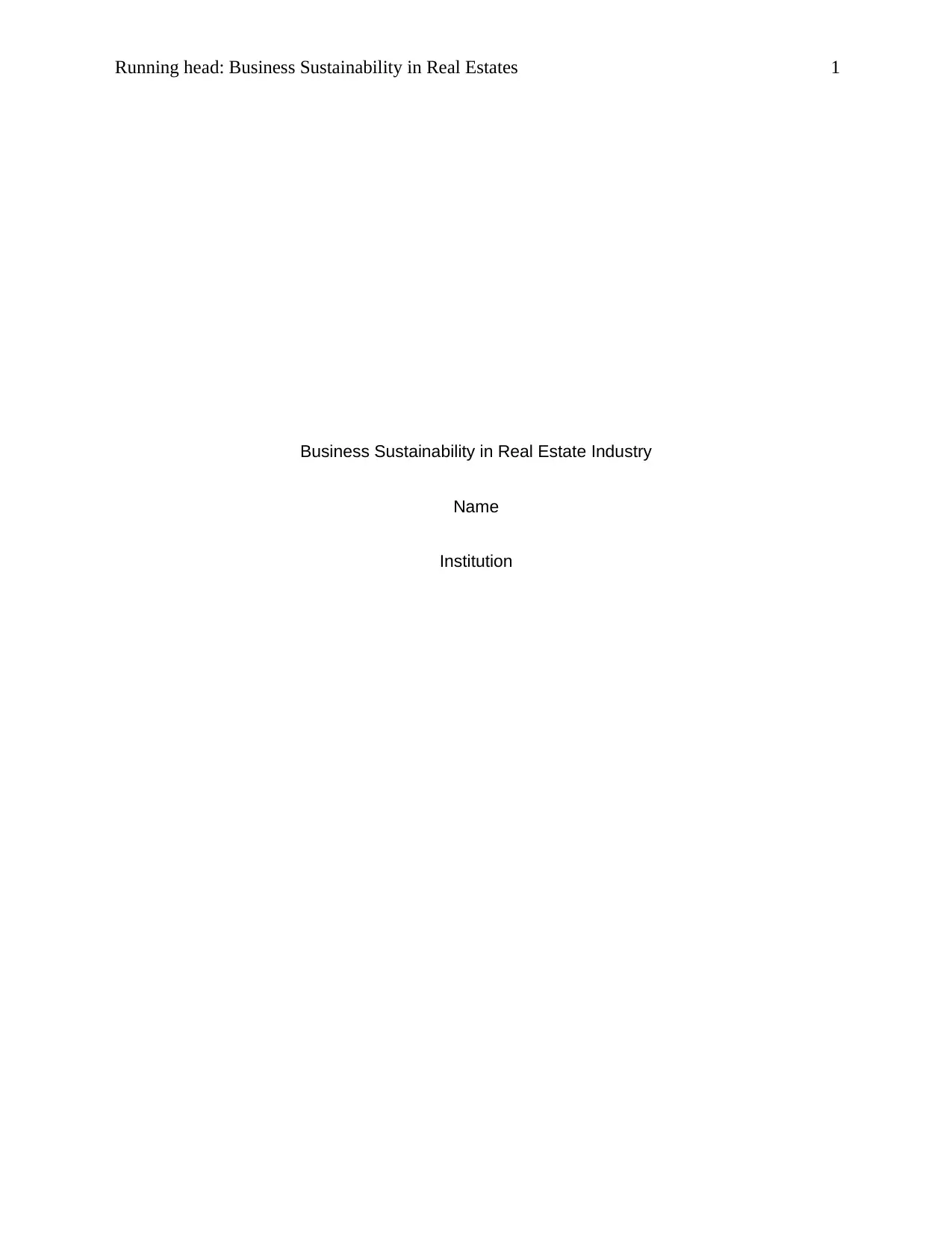
Running head: Business Sustainability in Real Estates 1
Business Sustainability in Real Estate Industry
Name
Institution
Business Sustainability in Real Estate Industry
Name
Institution
Paraphrase This Document
Need a fresh take? Get an instant paraphrase of this document with our AI Paraphraser
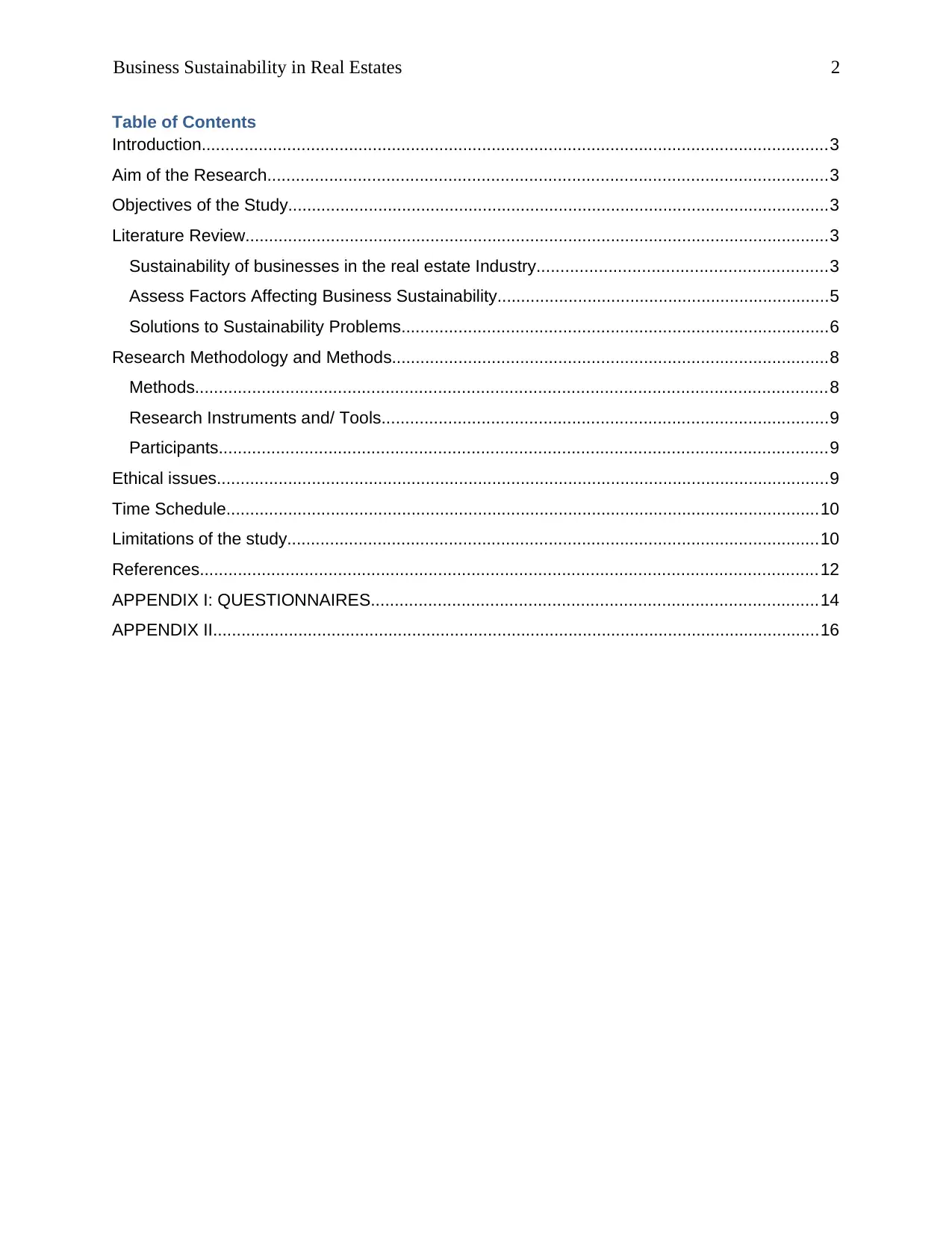
Business Sustainability in Real Estates 2
Table of Contents
Introduction....................................................................................................................................3
Aim of the Research......................................................................................................................3
Objectives of the Study..................................................................................................................3
Literature Review...........................................................................................................................3
Sustainability of businesses in the real estate Industry.............................................................3
Assess Factors Affecting Business Sustainability......................................................................5
Solutions to Sustainability Problems..........................................................................................6
Research Methodology and Methods............................................................................................8
Methods.....................................................................................................................................8
Research Instruments and/ Tools..............................................................................................9
Participants................................................................................................................................9
Ethical issues.................................................................................................................................9
Time Schedule.............................................................................................................................10
Limitations of the study................................................................................................................10
References..................................................................................................................................12
APPENDIX I: QUESTIONNAIRES..............................................................................................14
APPENDIX II................................................................................................................................16
Table of Contents
Introduction....................................................................................................................................3
Aim of the Research......................................................................................................................3
Objectives of the Study..................................................................................................................3
Literature Review...........................................................................................................................3
Sustainability of businesses in the real estate Industry.............................................................3
Assess Factors Affecting Business Sustainability......................................................................5
Solutions to Sustainability Problems..........................................................................................6
Research Methodology and Methods............................................................................................8
Methods.....................................................................................................................................8
Research Instruments and/ Tools..............................................................................................9
Participants................................................................................................................................9
Ethical issues.................................................................................................................................9
Time Schedule.............................................................................................................................10
Limitations of the study................................................................................................................10
References..................................................................................................................................12
APPENDIX I: QUESTIONNAIRES..............................................................................................14
APPENDIX II................................................................................................................................16
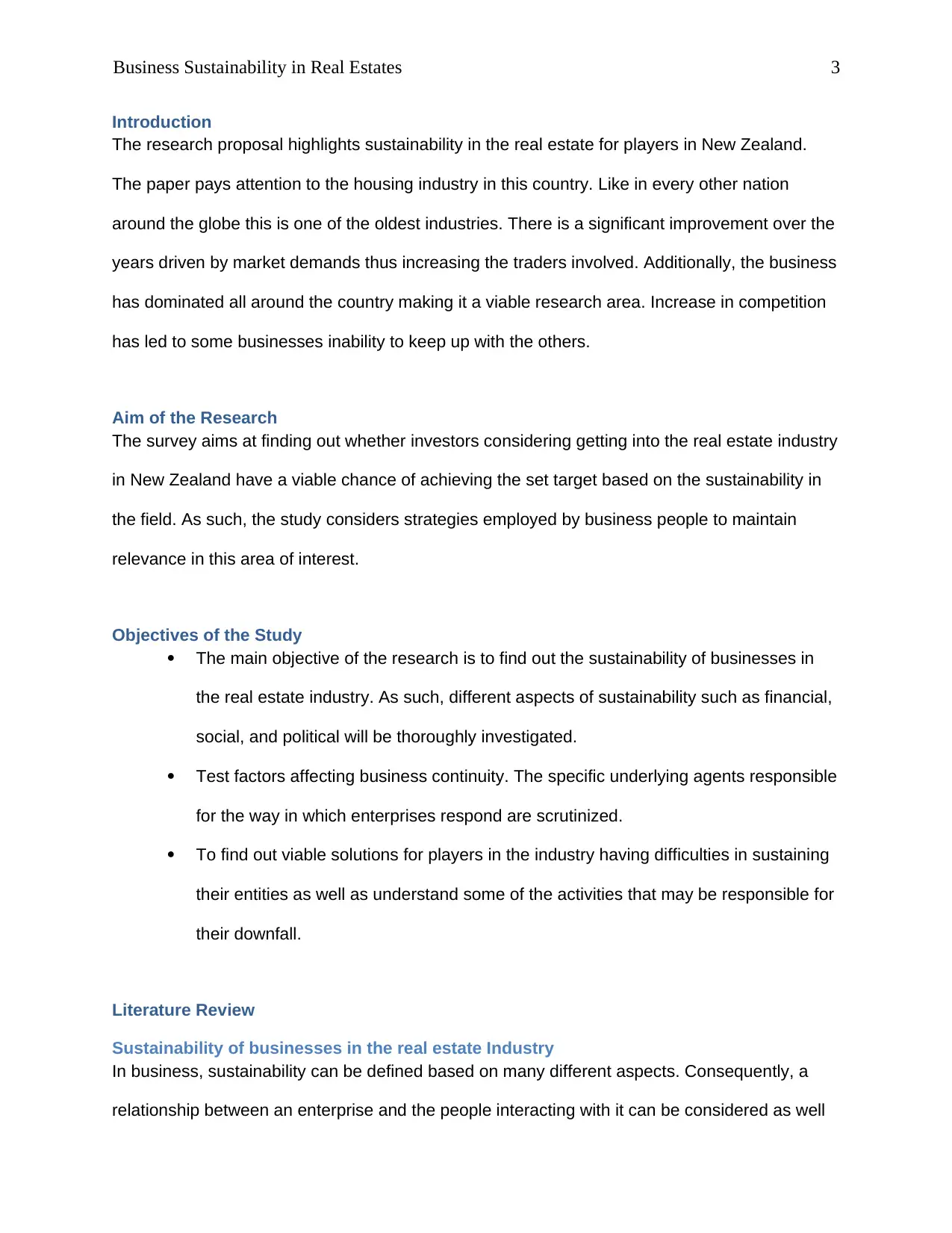
Business Sustainability in Real Estates 3
Introduction
The research proposal highlights sustainability in the real estate for players in New Zealand.
The paper pays attention to the housing industry in this country. Like in every other nation
around the globe this is one of the oldest industries. There is a significant improvement over the
years driven by market demands thus increasing the traders involved. Additionally, the business
has dominated all around the country making it a viable research area. Increase in competition
has led to some businesses inability to keep up with the others.
Aim of the Research
The survey aims at finding out whether investors considering getting into the real estate industry
in New Zealand have a viable chance of achieving the set target based on the sustainability in
the field. As such, the study considers strategies employed by business people to maintain
relevance in this area of interest.
Objectives of the Study
The main objective of the research is to find out the sustainability of businesses in
the real estate industry. As such, different aspects of sustainability such as financial,
social, and political will be thoroughly investigated.
Test factors affecting business continuity. The specific underlying agents responsible
for the way in which enterprises respond are scrutinized.
To find out viable solutions for players in the industry having difficulties in sustaining
their entities as well as understand some of the activities that may be responsible for
their downfall.
Literature Review
Sustainability of businesses in the real estate Industry
In business, sustainability can be defined based on many different aspects. Consequently, a
relationship between an enterprise and the people interacting with it can be considered as well
Introduction
The research proposal highlights sustainability in the real estate for players in New Zealand.
The paper pays attention to the housing industry in this country. Like in every other nation
around the globe this is one of the oldest industries. There is a significant improvement over the
years driven by market demands thus increasing the traders involved. Additionally, the business
has dominated all around the country making it a viable research area. Increase in competition
has led to some businesses inability to keep up with the others.
Aim of the Research
The survey aims at finding out whether investors considering getting into the real estate industry
in New Zealand have a viable chance of achieving the set target based on the sustainability in
the field. As such, the study considers strategies employed by business people to maintain
relevance in this area of interest.
Objectives of the Study
The main objective of the research is to find out the sustainability of businesses in
the real estate industry. As such, different aspects of sustainability such as financial,
social, and political will be thoroughly investigated.
Test factors affecting business continuity. The specific underlying agents responsible
for the way in which enterprises respond are scrutinized.
To find out viable solutions for players in the industry having difficulties in sustaining
their entities as well as understand some of the activities that may be responsible for
their downfall.
Literature Review
Sustainability of businesses in the real estate Industry
In business, sustainability can be defined based on many different aspects. Consequently, a
relationship between an enterprise and the people interacting with it can be considered as well
⊘ This is a preview!⊘
Do you want full access?
Subscribe today to unlock all pages.

Trusted by 1+ million students worldwide
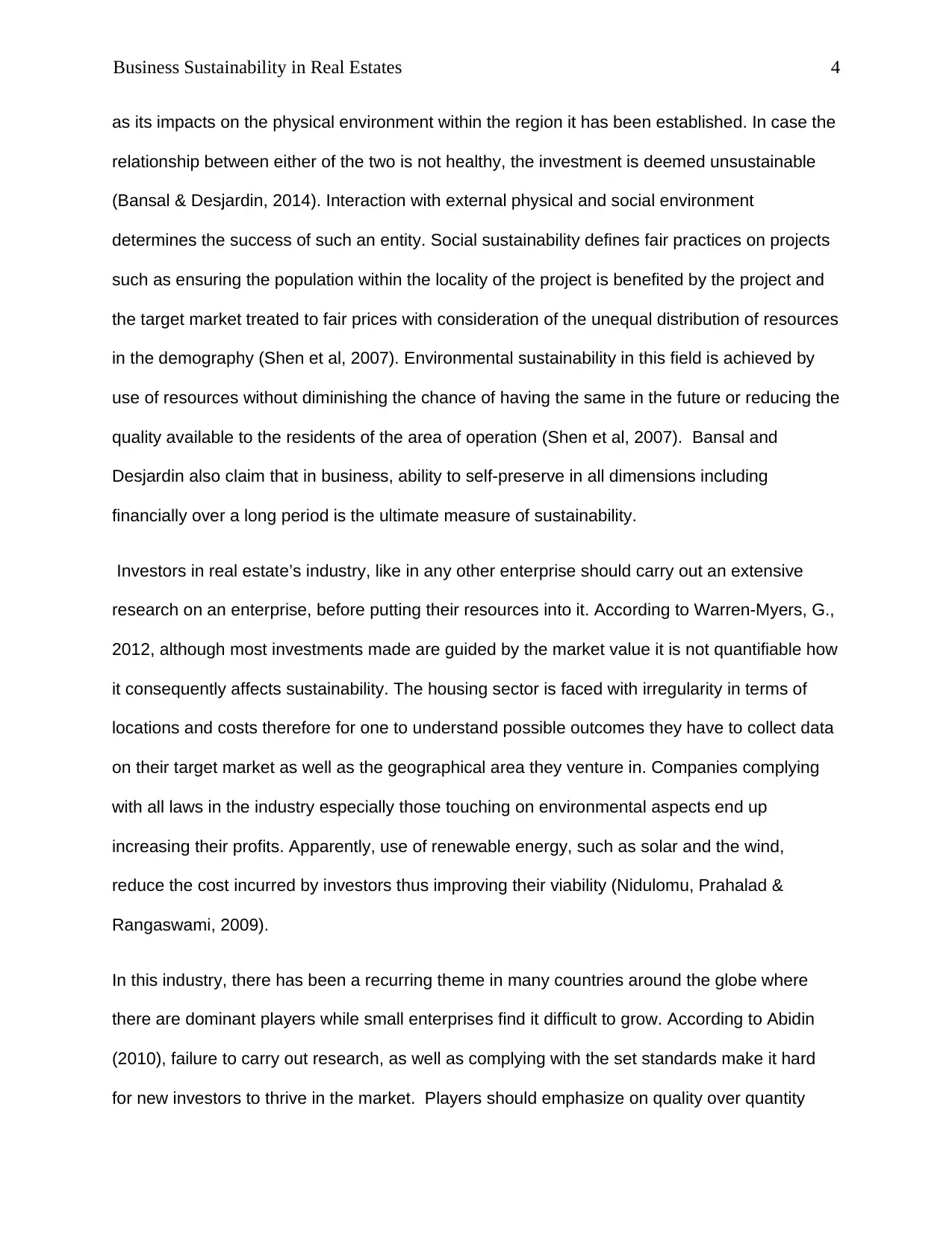
Business Sustainability in Real Estates 4
as its impacts on the physical environment within the region it has been established. In case the
relationship between either of the two is not healthy, the investment is deemed unsustainable
(Bansal & Desjardin, 2014). Interaction with external physical and social environment
determines the success of such an entity. Social sustainability defines fair practices on projects
such as ensuring the population within the locality of the project is benefited by the project and
the target market treated to fair prices with consideration of the unequal distribution of resources
in the demography (Shen et al, 2007). Environmental sustainability in this field is achieved by
use of resources without diminishing the chance of having the same in the future or reducing the
quality available to the residents of the area of operation (Shen et al, 2007). Bansal and
Desjardin also claim that in business, ability to self-preserve in all dimensions including
financially over a long period is the ultimate measure of sustainability.
Investors in real estate’s industry, like in any other enterprise should carry out an extensive
research on an enterprise, before putting their resources into it. According to Warren-Myers, G.,
2012, although most investments made are guided by the market value it is not quantifiable how
it consequently affects sustainability. The housing sector is faced with irregularity in terms of
locations and costs therefore for one to understand possible outcomes they have to collect data
on their target market as well as the geographical area they venture in. Companies complying
with all laws in the industry especially those touching on environmental aspects end up
increasing their profits. Apparently, use of renewable energy, such as solar and the wind,
reduce the cost incurred by investors thus improving their viability (Nidulomu, Prahalad &
Rangaswami, 2009).
In this industry, there has been a recurring theme in many countries around the globe where
there are dominant players while small enterprises find it difficult to grow. According to Abidin
(2010), failure to carry out research, as well as complying with the set standards make it hard
for new investors to thrive in the market. Players should emphasize on quality over quantity
as its impacts on the physical environment within the region it has been established. In case the
relationship between either of the two is not healthy, the investment is deemed unsustainable
(Bansal & Desjardin, 2014). Interaction with external physical and social environment
determines the success of such an entity. Social sustainability defines fair practices on projects
such as ensuring the population within the locality of the project is benefited by the project and
the target market treated to fair prices with consideration of the unequal distribution of resources
in the demography (Shen et al, 2007). Environmental sustainability in this field is achieved by
use of resources without diminishing the chance of having the same in the future or reducing the
quality available to the residents of the area of operation (Shen et al, 2007). Bansal and
Desjardin also claim that in business, ability to self-preserve in all dimensions including
financially over a long period is the ultimate measure of sustainability.
Investors in real estate’s industry, like in any other enterprise should carry out an extensive
research on an enterprise, before putting their resources into it. According to Warren-Myers, G.,
2012, although most investments made are guided by the market value it is not quantifiable how
it consequently affects sustainability. The housing sector is faced with irregularity in terms of
locations and costs therefore for one to understand possible outcomes they have to collect data
on their target market as well as the geographical area they venture in. Companies complying
with all laws in the industry especially those touching on environmental aspects end up
increasing their profits. Apparently, use of renewable energy, such as solar and the wind,
reduce the cost incurred by investors thus improving their viability (Nidulomu, Prahalad &
Rangaswami, 2009).
In this industry, there has been a recurring theme in many countries around the globe where
there are dominant players while small enterprises find it difficult to grow. According to Abidin
(2010), failure to carry out research, as well as complying with the set standards make it hard
for new investors to thrive in the market. Players should emphasize on quality over quantity
Paraphrase This Document
Need a fresh take? Get an instant paraphrase of this document with our AI Paraphraser
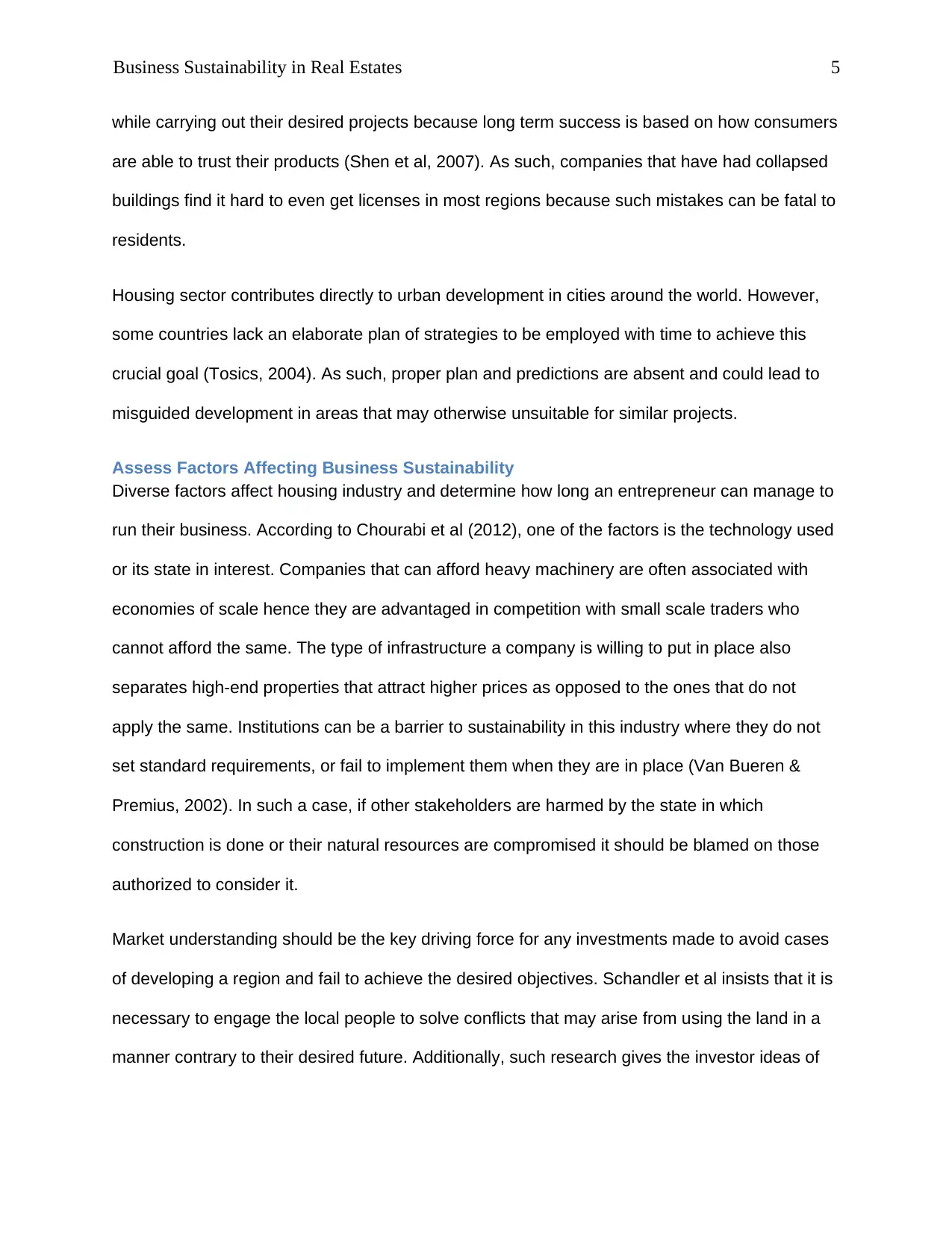
Business Sustainability in Real Estates 5
while carrying out their desired projects because long term success is based on how consumers
are able to trust their products (Shen et al, 2007). As such, companies that have had collapsed
buildings find it hard to even get licenses in most regions because such mistakes can be fatal to
residents.
Housing sector contributes directly to urban development in cities around the world. However,
some countries lack an elaborate plan of strategies to be employed with time to achieve this
crucial goal (Tosics, 2004). As such, proper plan and predictions are absent and could lead to
misguided development in areas that may otherwise unsuitable for similar projects.
Assess Factors Affecting Business Sustainability
Diverse factors affect housing industry and determine how long an entrepreneur can manage to
run their business. According to Chourabi et al (2012), one of the factors is the technology used
or its state in interest. Companies that can afford heavy machinery are often associated with
economies of scale hence they are advantaged in competition with small scale traders who
cannot afford the same. The type of infrastructure a company is willing to put in place also
separates high-end properties that attract higher prices as opposed to the ones that do not
apply the same. Institutions can be a barrier to sustainability in this industry where they do not
set standard requirements, or fail to implement them when they are in place (Van Bueren &
Premius, 2002). In such a case, if other stakeholders are harmed by the state in which
construction is done or their natural resources are compromised it should be blamed on those
authorized to consider it.
Market understanding should be the key driving force for any investments made to avoid cases
of developing a region and fail to achieve the desired objectives. Schandler et al insists that it is
necessary to engage the local people to solve conflicts that may arise from using the land in a
manner contrary to their desired future. Additionally, such research gives the investor ideas of
while carrying out their desired projects because long term success is based on how consumers
are able to trust their products (Shen et al, 2007). As such, companies that have had collapsed
buildings find it hard to even get licenses in most regions because such mistakes can be fatal to
residents.
Housing sector contributes directly to urban development in cities around the world. However,
some countries lack an elaborate plan of strategies to be employed with time to achieve this
crucial goal (Tosics, 2004). As such, proper plan and predictions are absent and could lead to
misguided development in areas that may otherwise unsuitable for similar projects.
Assess Factors Affecting Business Sustainability
Diverse factors affect housing industry and determine how long an entrepreneur can manage to
run their business. According to Chourabi et al (2012), one of the factors is the technology used
or its state in interest. Companies that can afford heavy machinery are often associated with
economies of scale hence they are advantaged in competition with small scale traders who
cannot afford the same. The type of infrastructure a company is willing to put in place also
separates high-end properties that attract higher prices as opposed to the ones that do not
apply the same. Institutions can be a barrier to sustainability in this industry where they do not
set standard requirements, or fail to implement them when they are in place (Van Bueren &
Premius, 2002). In such a case, if other stakeholders are harmed by the state in which
construction is done or their natural resources are compromised it should be blamed on those
authorized to consider it.
Market understanding should be the key driving force for any investments made to avoid cases
of developing a region and fail to achieve the desired objectives. Schandler et al insists that it is
necessary to engage the local people to solve conflicts that may arise from using the land in a
manner contrary to their desired future. Additionally, such research gives the investor ideas of
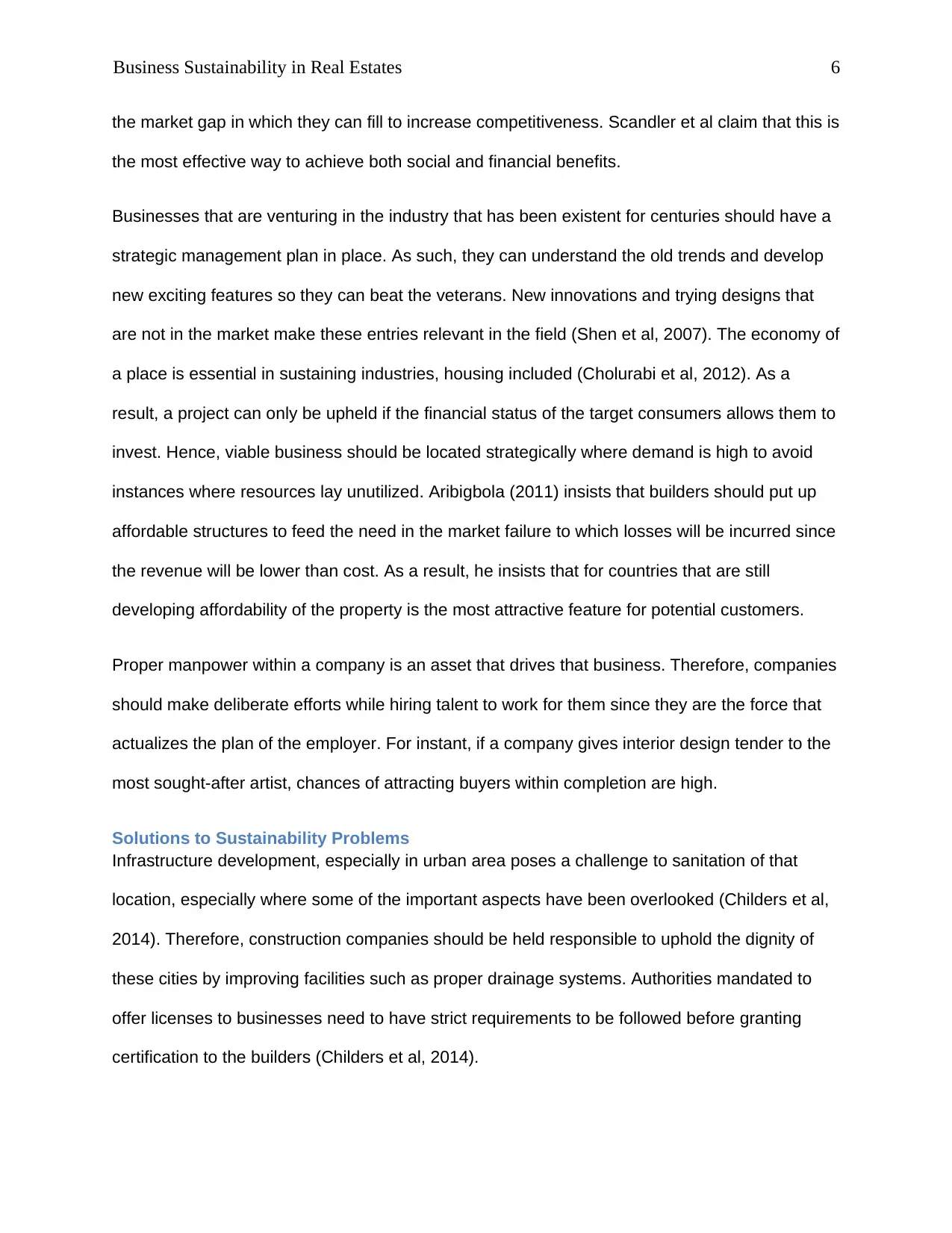
Business Sustainability in Real Estates 6
the market gap in which they can fill to increase competitiveness. Scandler et al claim that this is
the most effective way to achieve both social and financial benefits.
Businesses that are venturing in the industry that has been existent for centuries should have a
strategic management plan in place. As such, they can understand the old trends and develop
new exciting features so they can beat the veterans. New innovations and trying designs that
are not in the market make these entries relevant in the field (Shen et al, 2007). The economy of
a place is essential in sustaining industries, housing included (Cholurabi et al, 2012). As a
result, a project can only be upheld if the financial status of the target consumers allows them to
invest. Hence, viable business should be located strategically where demand is high to avoid
instances where resources lay unutilized. Aribigbola (2011) insists that builders should put up
affordable structures to feed the need in the market failure to which losses will be incurred since
the revenue will be lower than cost. As a result, he insists that for countries that are still
developing affordability of the property is the most attractive feature for potential customers.
Proper manpower within a company is an asset that drives that business. Therefore, companies
should make deliberate efforts while hiring talent to work for them since they are the force that
actualizes the plan of the employer. For instant, if a company gives interior design tender to the
most sought-after artist, chances of attracting buyers within completion are high.
Solutions to Sustainability Problems
Infrastructure development, especially in urban area poses a challenge to sanitation of that
location, especially where some of the important aspects have been overlooked (Childers et al,
2014). Therefore, construction companies should be held responsible to uphold the dignity of
these cities by improving facilities such as proper drainage systems. Authorities mandated to
offer licenses to businesses need to have strict requirements to be followed before granting
certification to the builders (Childers et al, 2014).
the market gap in which they can fill to increase competitiveness. Scandler et al claim that this is
the most effective way to achieve both social and financial benefits.
Businesses that are venturing in the industry that has been existent for centuries should have a
strategic management plan in place. As such, they can understand the old trends and develop
new exciting features so they can beat the veterans. New innovations and trying designs that
are not in the market make these entries relevant in the field (Shen et al, 2007). The economy of
a place is essential in sustaining industries, housing included (Cholurabi et al, 2012). As a
result, a project can only be upheld if the financial status of the target consumers allows them to
invest. Hence, viable business should be located strategically where demand is high to avoid
instances where resources lay unutilized. Aribigbola (2011) insists that builders should put up
affordable structures to feed the need in the market failure to which losses will be incurred since
the revenue will be lower than cost. As a result, he insists that for countries that are still
developing affordability of the property is the most attractive feature for potential customers.
Proper manpower within a company is an asset that drives that business. Therefore, companies
should make deliberate efforts while hiring talent to work for them since they are the force that
actualizes the plan of the employer. For instant, if a company gives interior design tender to the
most sought-after artist, chances of attracting buyers within completion are high.
Solutions to Sustainability Problems
Infrastructure development, especially in urban area poses a challenge to sanitation of that
location, especially where some of the important aspects have been overlooked (Childers et al,
2014). Therefore, construction companies should be held responsible to uphold the dignity of
these cities by improving facilities such as proper drainage systems. Authorities mandated to
offer licenses to businesses need to have strict requirements to be followed before granting
certification to the builders (Childers et al, 2014).
⊘ This is a preview!⊘
Do you want full access?
Subscribe today to unlock all pages.

Trusted by 1+ million students worldwide
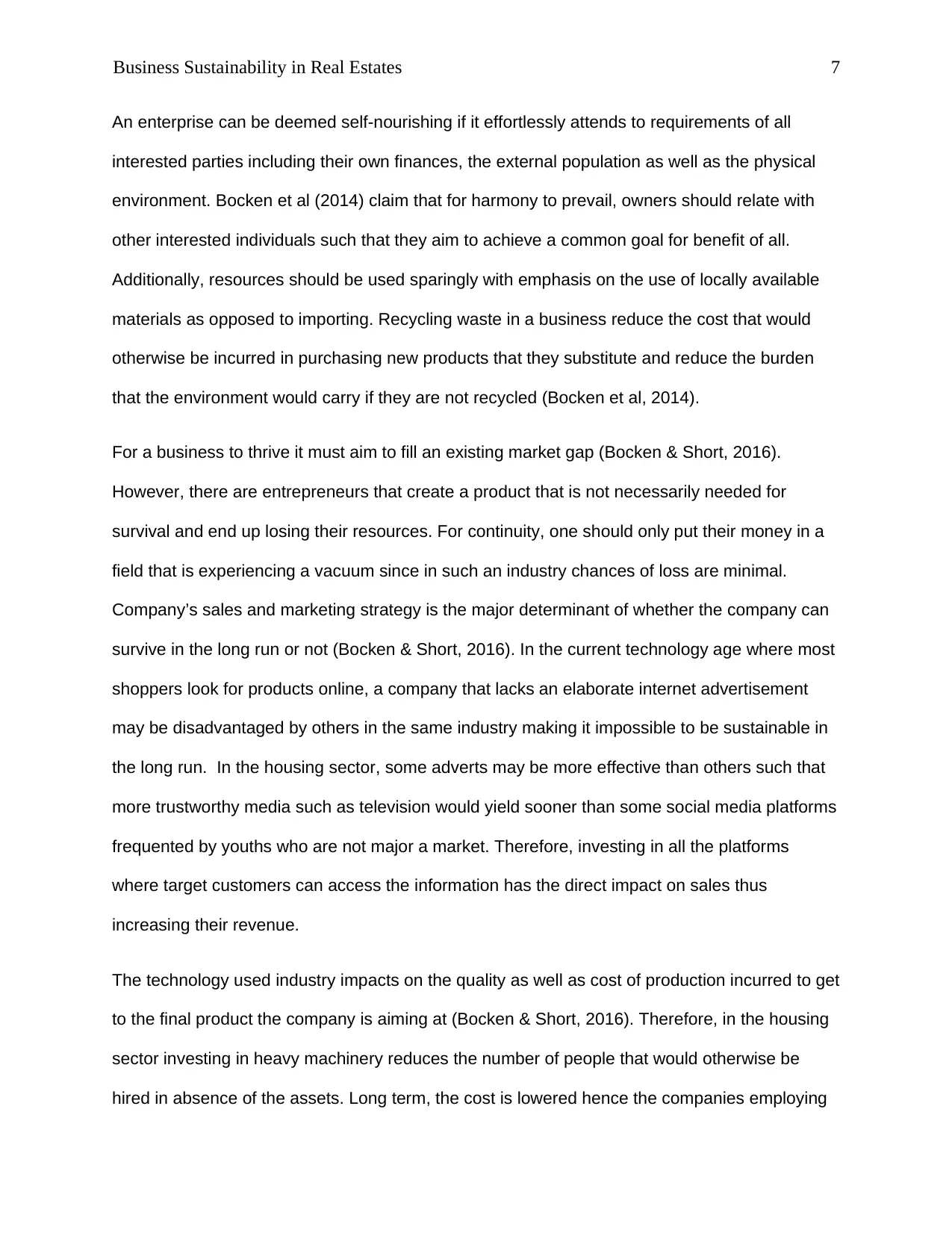
Business Sustainability in Real Estates 7
An enterprise can be deemed self-nourishing if it effortlessly attends to requirements of all
interested parties including their own finances, the external population as well as the physical
environment. Bocken et al (2014) claim that for harmony to prevail, owners should relate with
other interested individuals such that they aim to achieve a common goal for benefit of all.
Additionally, resources should be used sparingly with emphasis on the use of locally available
materials as opposed to importing. Recycling waste in a business reduce the cost that would
otherwise be incurred in purchasing new products that they substitute and reduce the burden
that the environment would carry if they are not recycled (Bocken et al, 2014).
For a business to thrive it must aim to fill an existing market gap (Bocken & Short, 2016).
However, there are entrepreneurs that create a product that is not necessarily needed for
survival and end up losing their resources. For continuity, one should only put their money in a
field that is experiencing a vacuum since in such an industry chances of loss are minimal.
Company’s sales and marketing strategy is the major determinant of whether the company can
survive in the long run or not (Bocken & Short, 2016). In the current technology age where most
shoppers look for products online, a company that lacks an elaborate internet advertisement
may be disadvantaged by others in the same industry making it impossible to be sustainable in
the long run. In the housing sector, some adverts may be more effective than others such that
more trustworthy media such as television would yield sooner than some social media platforms
frequented by youths who are not major a market. Therefore, investing in all the platforms
where target customers can access the information has the direct impact on sales thus
increasing their revenue.
The technology used industry impacts on the quality as well as cost of production incurred to get
to the final product the company is aiming at (Bocken & Short, 2016). Therefore, in the housing
sector investing in heavy machinery reduces the number of people that would otherwise be
hired in absence of the assets. Long term, the cost is lowered hence the companies employing
An enterprise can be deemed self-nourishing if it effortlessly attends to requirements of all
interested parties including their own finances, the external population as well as the physical
environment. Bocken et al (2014) claim that for harmony to prevail, owners should relate with
other interested individuals such that they aim to achieve a common goal for benefit of all.
Additionally, resources should be used sparingly with emphasis on the use of locally available
materials as opposed to importing. Recycling waste in a business reduce the cost that would
otherwise be incurred in purchasing new products that they substitute and reduce the burden
that the environment would carry if they are not recycled (Bocken et al, 2014).
For a business to thrive it must aim to fill an existing market gap (Bocken & Short, 2016).
However, there are entrepreneurs that create a product that is not necessarily needed for
survival and end up losing their resources. For continuity, one should only put their money in a
field that is experiencing a vacuum since in such an industry chances of loss are minimal.
Company’s sales and marketing strategy is the major determinant of whether the company can
survive in the long run or not (Bocken & Short, 2016). In the current technology age where most
shoppers look for products online, a company that lacks an elaborate internet advertisement
may be disadvantaged by others in the same industry making it impossible to be sustainable in
the long run. In the housing sector, some adverts may be more effective than others such that
more trustworthy media such as television would yield sooner than some social media platforms
frequented by youths who are not major a market. Therefore, investing in all the platforms
where target customers can access the information has the direct impact on sales thus
increasing their revenue.
The technology used industry impacts on the quality as well as cost of production incurred to get
to the final product the company is aiming at (Bocken & Short, 2016). Therefore, in the housing
sector investing in heavy machinery reduces the number of people that would otherwise be
hired in absence of the assets. Long term, the cost is lowered hence the companies employing
Paraphrase This Document
Need a fresh take? Get an instant paraphrase of this document with our AI Paraphraser
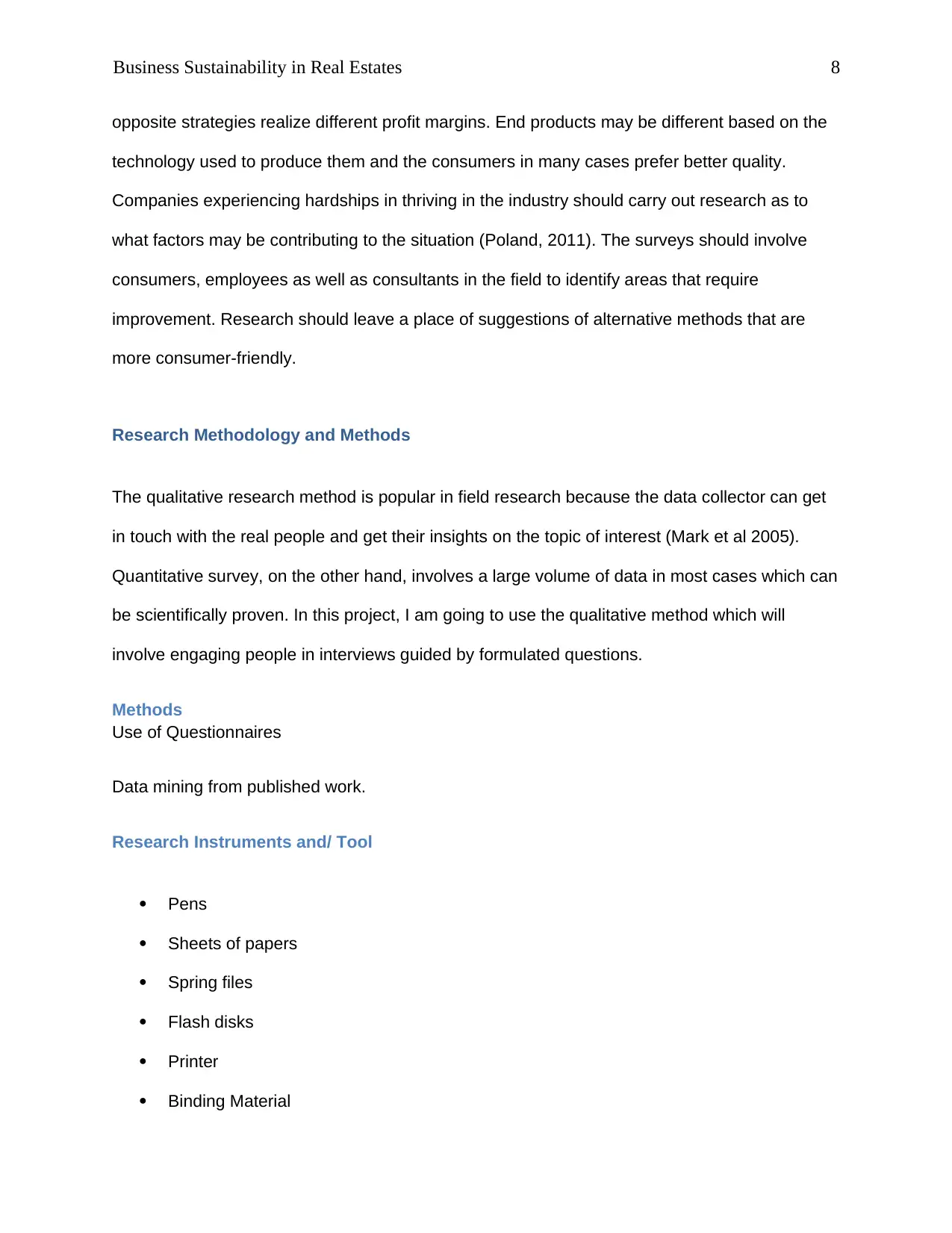
Business Sustainability in Real Estates 8
opposite strategies realize different profit margins. End products may be different based on the
technology used to produce them and the consumers in many cases prefer better quality.
Companies experiencing hardships in thriving in the industry should carry out research as to
what factors may be contributing to the situation (Poland, 2011). The surveys should involve
consumers, employees as well as consultants in the field to identify areas that require
improvement. Research should leave a place of suggestions of alternative methods that are
more consumer-friendly.
Research Methodology and Methods
The qualitative research method is popular in field research because the data collector can get
in touch with the real people and get their insights on the topic of interest (Mark et al 2005).
Quantitative survey, on the other hand, involves a large volume of data in most cases which can
be scientifically proven. In this project, I am going to use the qualitative method which will
involve engaging people in interviews guided by formulated questions.
Methods
Use of Questionnaires
Data mining from published work.
Research Instruments and/ Tool
Pens
Sheets of papers
Spring files
Flash disks
Printer
Binding Material
opposite strategies realize different profit margins. End products may be different based on the
technology used to produce them and the consumers in many cases prefer better quality.
Companies experiencing hardships in thriving in the industry should carry out research as to
what factors may be contributing to the situation (Poland, 2011). The surveys should involve
consumers, employees as well as consultants in the field to identify areas that require
improvement. Research should leave a place of suggestions of alternative methods that are
more consumer-friendly.
Research Methodology and Methods
The qualitative research method is popular in field research because the data collector can get
in touch with the real people and get their insights on the topic of interest (Mark et al 2005).
Quantitative survey, on the other hand, involves a large volume of data in most cases which can
be scientifically proven. In this project, I am going to use the qualitative method which will
involve engaging people in interviews guided by formulated questions.
Methods
Use of Questionnaires
Data mining from published work.
Research Instruments and/ Tool
Pens
Sheets of papers
Spring files
Flash disks
Printer
Binding Material
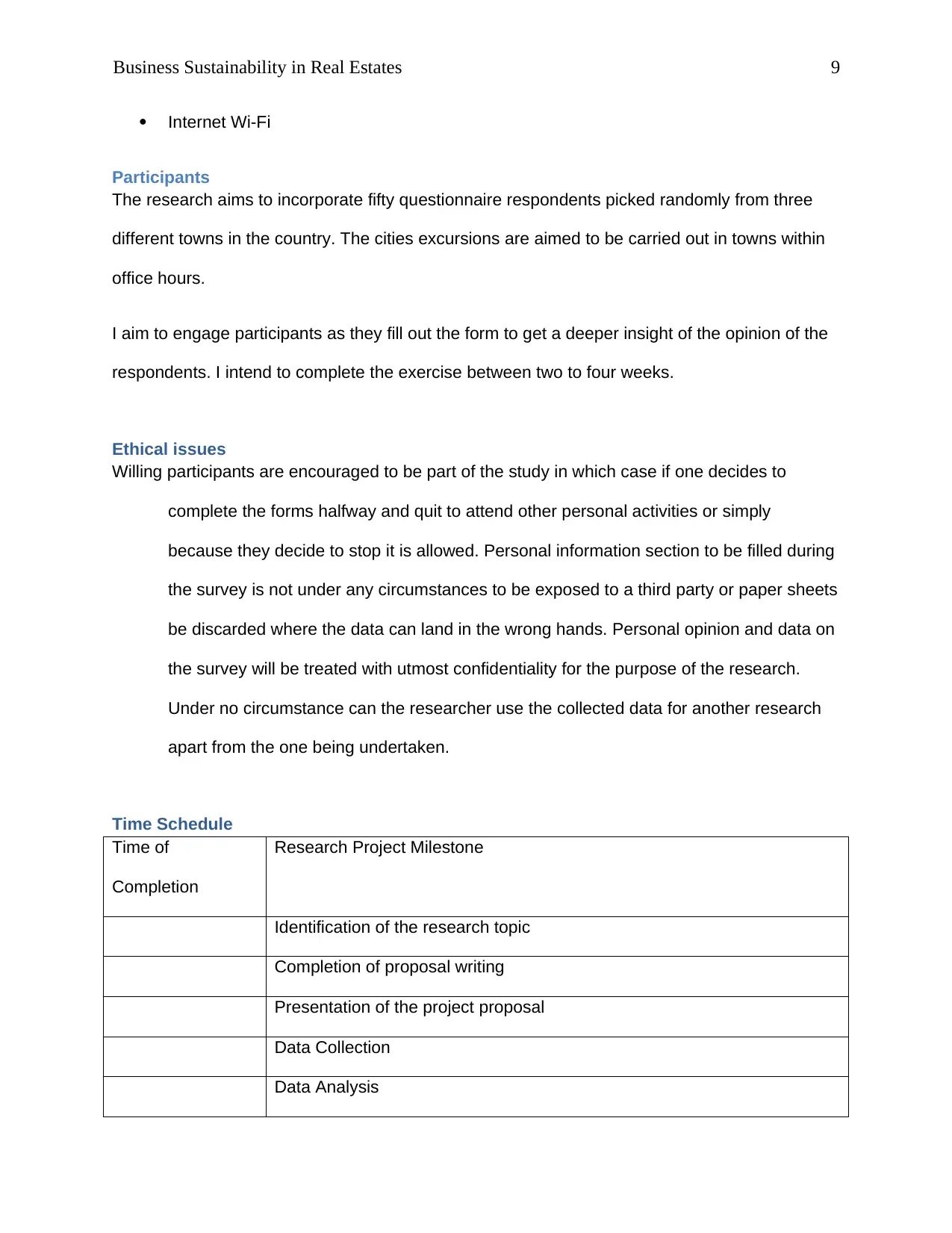
Business Sustainability in Real Estates 9
Internet Wi-Fi
Participants
The research aims to incorporate fifty questionnaire respondents picked randomly from three
different towns in the country. The cities excursions are aimed to be carried out in towns within
office hours.
I aim to engage participants as they fill out the form to get a deeper insight of the opinion of the
respondents. I intend to complete the exercise between two to four weeks.
Ethical issues
Willing participants are encouraged to be part of the study in which case if one decides to
complete the forms halfway and quit to attend other personal activities or simply
because they decide to stop it is allowed. Personal information section to be filled during
the survey is not under any circumstances to be exposed to a third party or paper sheets
be discarded where the data can land in the wrong hands. Personal opinion and data on
the survey will be treated with utmost confidentiality for the purpose of the research.
Under no circumstance can the researcher use the collected data for another research
apart from the one being undertaken.
Time Schedule
Time of
Completion
Research Project Milestone
Identification of the research topic
Completion of proposal writing
Presentation of the project proposal
Data Collection
Data Analysis
Internet Wi-Fi
Participants
The research aims to incorporate fifty questionnaire respondents picked randomly from three
different towns in the country. The cities excursions are aimed to be carried out in towns within
office hours.
I aim to engage participants as they fill out the form to get a deeper insight of the opinion of the
respondents. I intend to complete the exercise between two to four weeks.
Ethical issues
Willing participants are encouraged to be part of the study in which case if one decides to
complete the forms halfway and quit to attend other personal activities or simply
because they decide to stop it is allowed. Personal information section to be filled during
the survey is not under any circumstances to be exposed to a third party or paper sheets
be discarded where the data can land in the wrong hands. Personal opinion and data on
the survey will be treated with utmost confidentiality for the purpose of the research.
Under no circumstance can the researcher use the collected data for another research
apart from the one being undertaken.
Time Schedule
Time of
Completion
Research Project Milestone
Identification of the research topic
Completion of proposal writing
Presentation of the project proposal
Data Collection
Data Analysis
⊘ This is a preview!⊘
Do you want full access?
Subscribe today to unlock all pages.

Trusted by 1+ million students worldwide
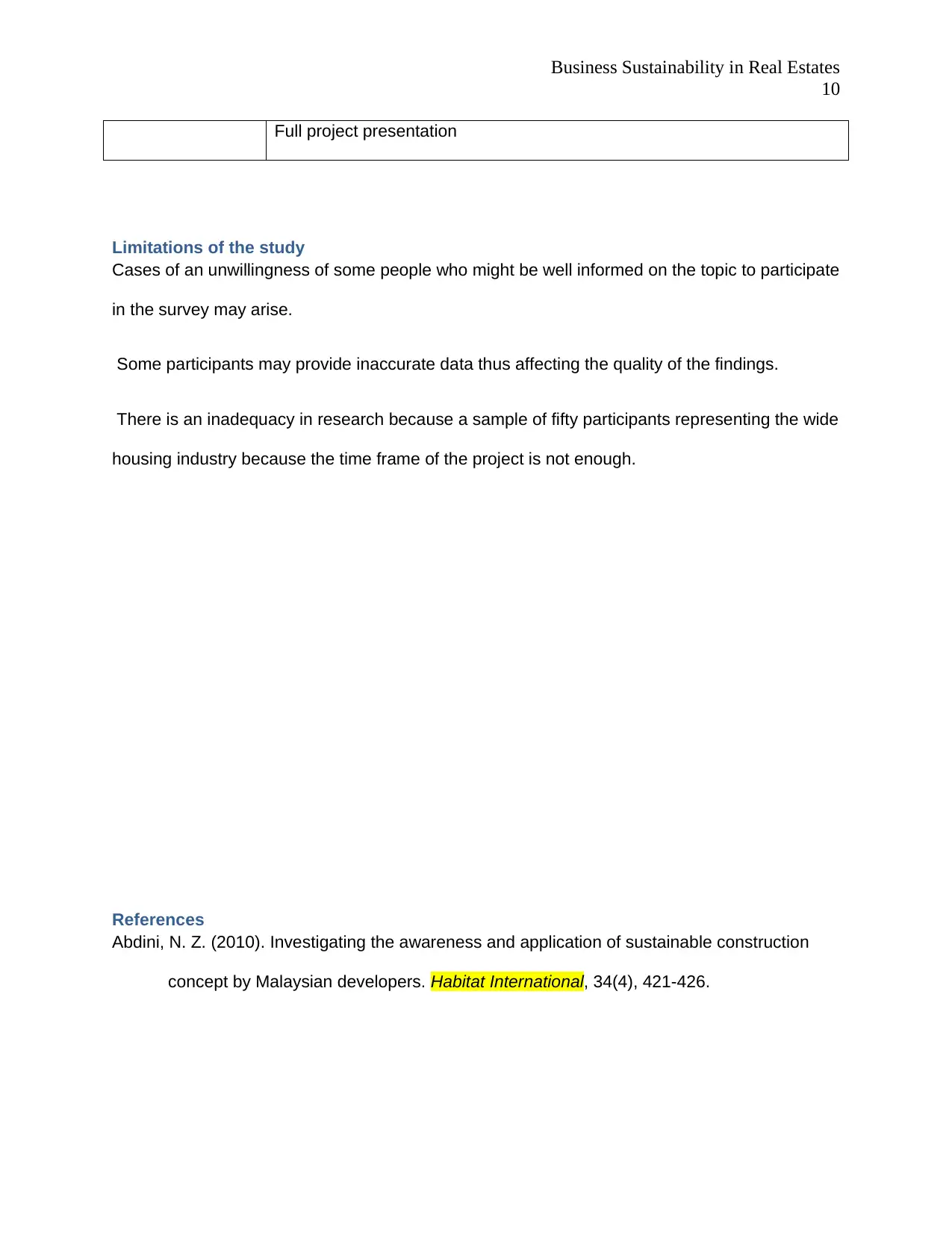
Business Sustainability in Real Estates
10
Full project presentation
Limitations of the study
Cases of an unwillingness of some people who might be well informed on the topic to participate
in the survey may arise.
Some participants may provide inaccurate data thus affecting the quality of the findings.
There is an inadequacy in research because a sample of fifty participants representing the wide
housing industry because the time frame of the project is not enough.
References
Abdini, N. Z. (2010). Investigating the awareness and application of sustainable construction
concept by Malaysian developers. Habitat International, 34(4), 421-426.
10
Full project presentation
Limitations of the study
Cases of an unwillingness of some people who might be well informed on the topic to participate
in the survey may arise.
Some participants may provide inaccurate data thus affecting the quality of the findings.
There is an inadequacy in research because a sample of fifty participants representing the wide
housing industry because the time frame of the project is not enough.
References
Abdini, N. Z. (2010). Investigating the awareness and application of sustainable construction
concept by Malaysian developers. Habitat International, 34(4), 421-426.
Paraphrase This Document
Need a fresh take? Get an instant paraphrase of this document with our AI Paraphraser
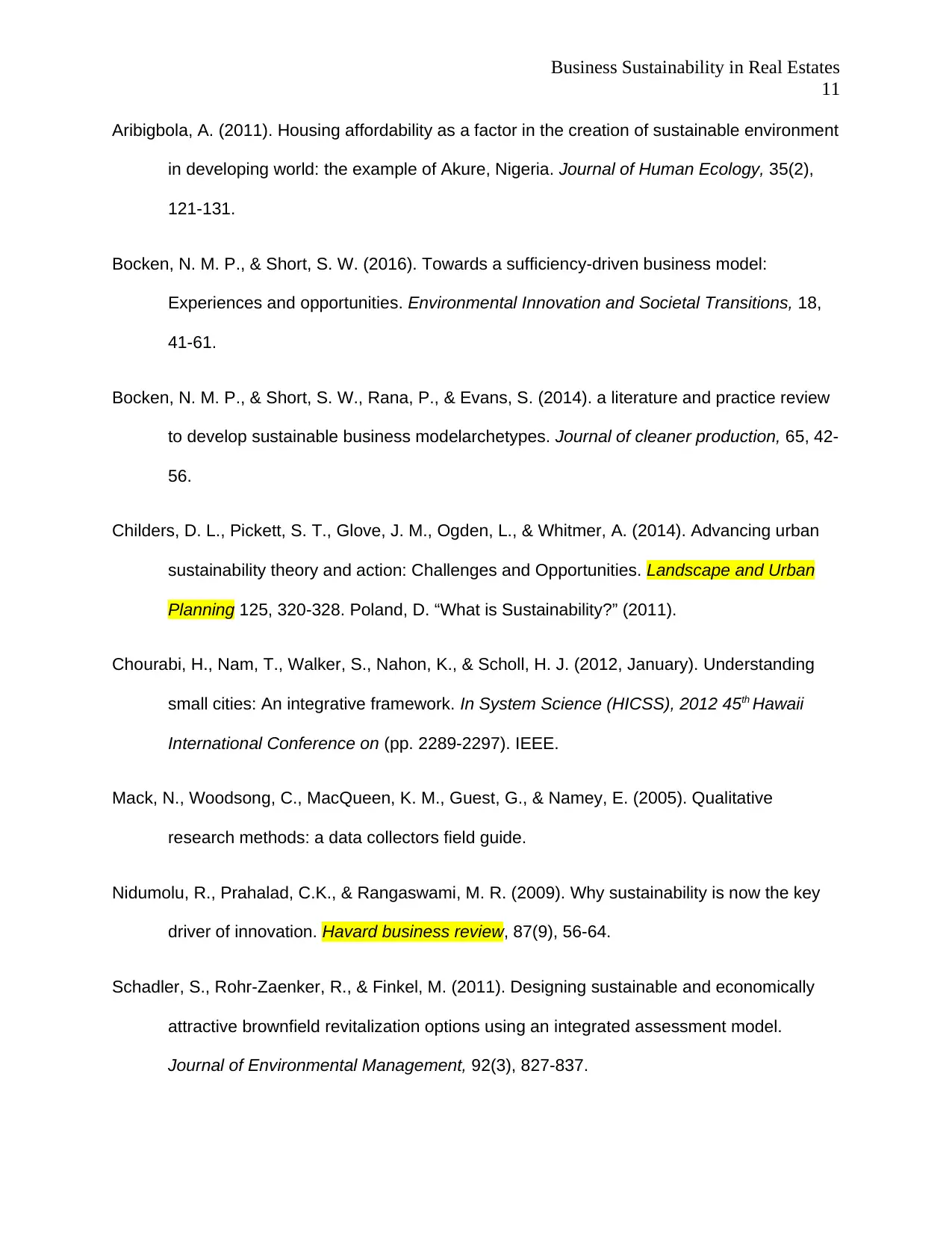
Business Sustainability in Real Estates
11
Aribigbola, A. (2011). Housing affordability as a factor in the creation of sustainable environment
in developing world: the example of Akure, Nigeria. Journal of Human Ecology, 35(2),
121-131.
Bocken, N. M. P., & Short, S. W. (2016). Towards a sufficiency-driven business model:
Experiences and opportunities. Environmental Innovation and Societal Transitions, 18,
41-61.
Bocken, N. M. P., & Short, S. W., Rana, P., & Evans, S. (2014). a literature and practice review
to develop sustainable business modelarchetypes. Journal of cleaner production, 65, 42-
56.
Childers, D. L., Pickett, S. T., Glove, J. M., Ogden, L., & Whitmer, A. (2014). Advancing urban
sustainability theory and action: Challenges and Opportunities. Landscape and Urban
Planning 125, 320-328. Poland, D. “What is Sustainability?” (2011).
Chourabi, H., Nam, T., Walker, S., Nahon, K., & Scholl, H. J. (2012, January). Understanding
small cities: An integrative framework. In System Science (HICSS), 2012 45th Hawaii
International Conference on (pp. 2289-2297). IEEE.
Mack, N., Woodsong, C., MacQueen, K. M., Guest, G., & Namey, E. (2005). Qualitative
research methods: a data collectors field guide.
Nidumolu, R., Prahalad, C.K., & Rangaswami, M. R. (2009). Why sustainability is now the key
driver of innovation. Havard business review, 87(9), 56-64.
Schadler, S., Rohr-Zaenker, R., & Finkel, M. (2011). Designing sustainable and economically
attractive brownfield revitalization options using an integrated assessment model.
Journal of Environmental Management, 92(3), 827-837.
11
Aribigbola, A. (2011). Housing affordability as a factor in the creation of sustainable environment
in developing world: the example of Akure, Nigeria. Journal of Human Ecology, 35(2),
121-131.
Bocken, N. M. P., & Short, S. W. (2016). Towards a sufficiency-driven business model:
Experiences and opportunities. Environmental Innovation and Societal Transitions, 18,
41-61.
Bocken, N. M. P., & Short, S. W., Rana, P., & Evans, S. (2014). a literature and practice review
to develop sustainable business modelarchetypes. Journal of cleaner production, 65, 42-
56.
Childers, D. L., Pickett, S. T., Glove, J. M., Ogden, L., & Whitmer, A. (2014). Advancing urban
sustainability theory and action: Challenges and Opportunities. Landscape and Urban
Planning 125, 320-328. Poland, D. “What is Sustainability?” (2011).
Chourabi, H., Nam, T., Walker, S., Nahon, K., & Scholl, H. J. (2012, January). Understanding
small cities: An integrative framework. In System Science (HICSS), 2012 45th Hawaii
International Conference on (pp. 2289-2297). IEEE.
Mack, N., Woodsong, C., MacQueen, K. M., Guest, G., & Namey, E. (2005). Qualitative
research methods: a data collectors field guide.
Nidumolu, R., Prahalad, C.K., & Rangaswami, M. R. (2009). Why sustainability is now the key
driver of innovation. Havard business review, 87(9), 56-64.
Schadler, S., Rohr-Zaenker, R., & Finkel, M. (2011). Designing sustainable and economically
attractive brownfield revitalization options using an integrated assessment model.
Journal of Environmental Management, 92(3), 827-837.
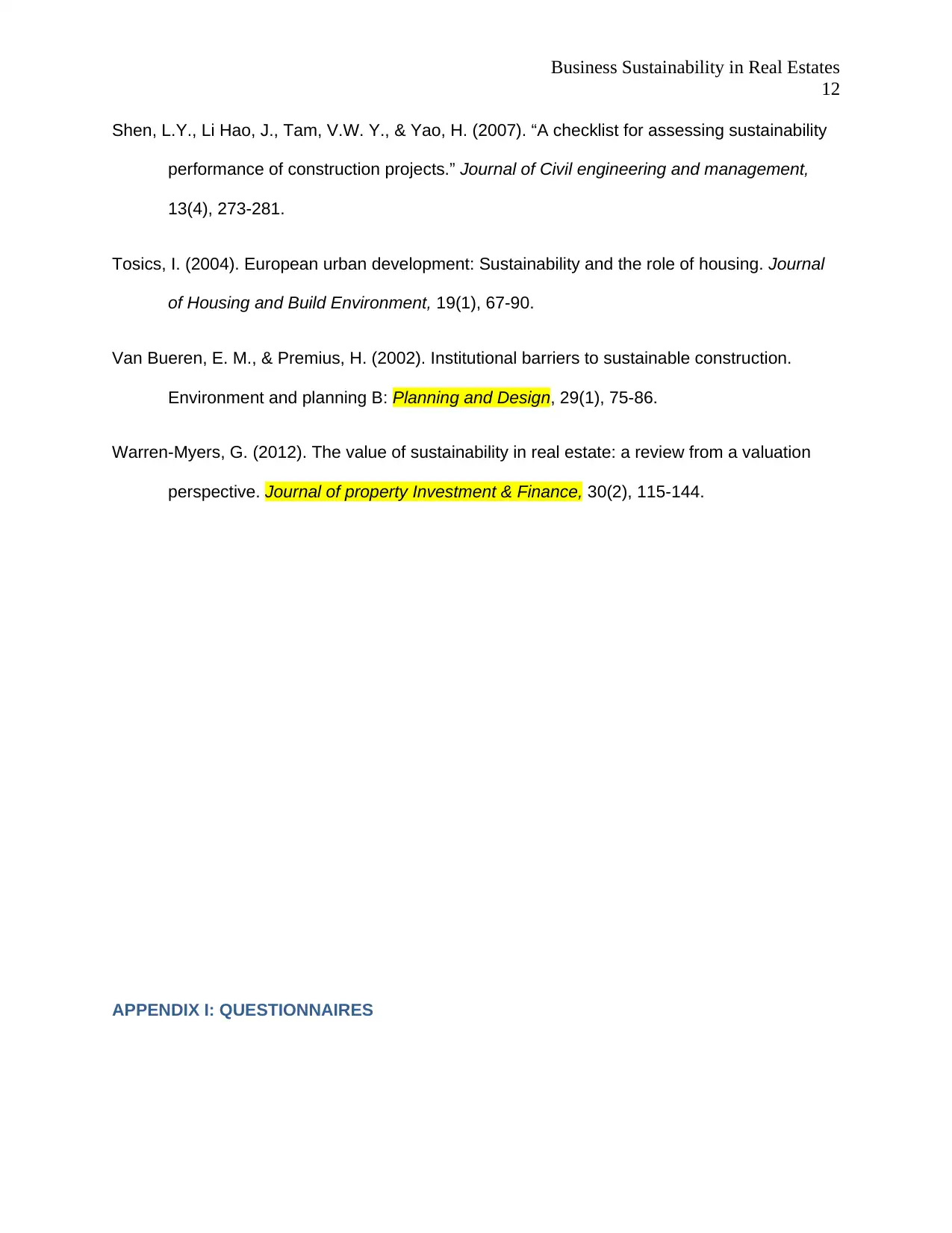
Business Sustainability in Real Estates
12
Shen, L.Y., Li Hao, J., Tam, V.W. Y., & Yao, H. (2007). “A checklist for assessing sustainability
performance of construction projects.” Journal of Civil engineering and management,
13(4), 273-281.
Tosics, I. (2004). European urban development: Sustainability and the role of housing. Journal
of Housing and Build Environment, 19(1), 67-90.
Van Bueren, E. M., & Premius, H. (2002). Institutional barriers to sustainable construction.
Environment and planning B: Planning and Design, 29(1), 75-86.
Warren-Myers, G. (2012). The value of sustainability in real estate: a review from a valuation
perspective. Journal of property Investment & Finance, 30(2), 115-144.
APPENDIX I: QUESTIONNAIRES
12
Shen, L.Y., Li Hao, J., Tam, V.W. Y., & Yao, H. (2007). “A checklist for assessing sustainability
performance of construction projects.” Journal of Civil engineering and management,
13(4), 273-281.
Tosics, I. (2004). European urban development: Sustainability and the role of housing. Journal
of Housing and Build Environment, 19(1), 67-90.
Van Bueren, E. M., & Premius, H. (2002). Institutional barriers to sustainable construction.
Environment and planning B: Planning and Design, 29(1), 75-86.
Warren-Myers, G. (2012). The value of sustainability in real estate: a review from a valuation
perspective. Journal of property Investment & Finance, 30(2), 115-144.
APPENDIX I: QUESTIONNAIRES
⊘ This is a preview!⊘
Do you want full access?
Subscribe today to unlock all pages.

Trusted by 1+ million students worldwide
1 out of 15
Related Documents
Your All-in-One AI-Powered Toolkit for Academic Success.
+13062052269
info@desklib.com
Available 24*7 on WhatsApp / Email
![[object Object]](/_next/static/media/star-bottom.7253800d.svg)
Unlock your academic potential
Copyright © 2020–2025 A2Z Services. All Rights Reserved. Developed and managed by ZUCOL.




